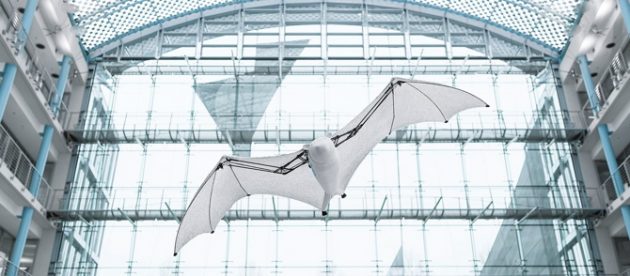
Festo debuts bionic spider and bat
By Canadian Packaging staff
Automation General Robotics BionicFlyingFox BionicWheelBot robotic spider Festo Festo Bionic Learning Network kinematicsLooking like a miniature battle droid from Star Wars, comes the new rolling Festo spiderbot—plus a robot bat that teaches itself how to fly.
German electrical automation giant Festo enjoys showing off its bionic capabilities, having previously brought us a robotic penguin, butterfly, dragonfly and yes, even a kangaroo, but for 2018, it has debuted a spider and a bat.
The BionicWheelBot robotic spider from Festo was inspired by the real-life flic-flac spider (cebrennus rechenbergi). The real spider lives in the Erg Chebbi desert on the edge of the Sahara, and was discovered by professor Ingo Rechenberg, a bionics processor at the TU Berlin in 2008.
In its native desert habitat, that spider walks normally on uneven ground—and can even propel itself up into the air using rolls/somersaults, enabling it to move twice as fast as walking.
Since its discovery, Rechenberg has been working on transferring its movement patterns to the technical field. The studies into the spider’s behavior led to the design of various robots that can propel themselves on difficult terrain.
For the BionicWheelBot, Rechenberg has developed the kinematics and drive concept together with Festo’s bionics team.
In order to start rolling, the BionicWheelBot bends three legs each on the left and right of its body to make a wheel. Two legs folded up whilst walking then extend, push the rolled-up spider off the ground, and continuously push it forward whilst rolling.
This prevents the BionicWheelBot from grinding to a halt and ensures that it can move itself forward even on rough terrain.
In rolling mode, the artificial spider—like its natural role model–is much faster than when walking. At the same time, the robot can even overcome inclines of up to five per cent uphill.

As for the bat, Festo calls its latest creation the BionicFlyingFox, an ultra lightweight flying object with intelligent kinematics.
Festo’s developers from its Bionic Learning Network took a close look at the real-life flying fox (the only mammal that can fly… without an ticket, that is) and technically implemented its special flying characteristics.
With a combination of the integrated on-board electronics and an external motion-tracking system, the BionicFlyingFox is able to move semi-autonomously in a defined airspace.
With a wingspan of 228 centimeters and a body length of 87 cm, the artificial flying fox weighs just 580 grams.
Like the natural flying fox, its wing kinematics are divided into primaries and secondaries and covered with an elastic membrane from the wings down to the feet, giving it a large wing area.
As with the biological model, all the articulation points are on one plane, meaning that the BionicFlyingFox can control and fold its wings together individually.
The model’s flying membrane is extremely thin, but robust consisting of two airtight films and a knitted elastane fabric, which are welded together at approximately 45,000 points.
Because of its elasticity, it stays almost uncreased, even when the wings are retracted.
The fabric’s honeycomb structure prevents small cracks in the flying membrane from getting bigger. This means that the BionicFlyingFox can continue flying even if the fabric sustains minor damage.
The BionicFlyingFox communicates with a motion-tracking system that constantly records its position. At the same time, the system plans the flight paths and delivers the necessary control commands for this. A person performs the start and landing manually, but the autopilot takes over in flight.
An important part of the motion-tracking system is two infrared cameras, which rest on a pan-tilt unit. This allows them to be rotated and tilted in such a way that they can track the entire flight of the BionicFlyingFox from the ground. The cameras detect the flying fox by means of four active infrared markers attached to the legs and wing tips.
The images from the BionicFlyingFox’s cameras go to a central master computer that evaluates the data and coordinates the flight from outside like an air traffic controller.
Pre-programmed paths are stored on the computer, which specify the flight path for the BionicFlyingFox when performing its maneuvers.
The wing movements required to ideally implement the intended courses are calculated by the artificial flying fox itself with the help of its on-board electronics and complex behavior patterns.
The BionicFlyingFox gets the control algorithms necessary for this from the master computer, where it is automatically learned and constantly improved upon—the BionicFlyingFox learns how to fly better every time it flies.
Company information available at www.festo.com.
Advertisement

